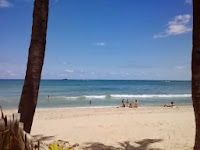| |
By Jane Feehan
One of the most enduring stories of Fort Lauderdale and World War II is that of missing Flight 19.
Lieutenant Charles C. Taylor led a squadron of five TBM Avenger torpedo bombers that took off from the U.S. Naval Air Station, Fort Lauderdale, at about 2 p.m. December 5, 1945. This mission was to take 14 crewmen (an additional member remained ashore because of a hangover) on its last training flight. The planes were to fly 77 miles due east to Great Stirrup Key, then 84 miles north to Great Sale and back to Fort Lauderdale. Another squadron flew the same route 30 minutes ahead.
At around 4 p.m. Taylor radioed that both his compasses were not working. He said he was in the Keys but didn’t know how far down and wasn’t sure how to get back to Fort Lauderdale. The last discernible radio transmission at 5:25 p.m. estimated location at about 200 miles north of Miami.
The dark blue 14,000-pound Avenger, built by Eastern Aircraft under license from Grumman, was the largest single-engine plane ever built; it proved to be a reliable aircraft during World War II. On the December 5 mission, Flight 19 had enough fuel until 8 p.m. that night. The planes would have sunk immediately if ditched into the ocean.
 |
| Avenger aircraft Florida State Archives |
A decision was made to search for Taylor and the squadron two hours after the last communication.
A sixth plane with 13 on board tasked as a rescue team took off at 7:30 p.m. and also not heard from again. A ship's crew reported having seen a mid-air flame, possibly an explosion and later an oil slick. For five days hundreds of planes searched for the 27 missing crewmen. Nothing more was ever found of the rescue plane or the five Avengers of Flight 19.
The U.S. Navy assumes Flight 19 ran out of fuel east of Florida and sank in storm-churned waters. Lieutenant Charles Taylor was absolved of responsibility for its fate; bad weather was deemed as probable cause of the mystery. Some of his peers thought Taylor to be a poor navigator. A news story written years after the disappearance reported he once got lost flying out of a base in the Keys and wound up on a raft in the Caribbean for five days.
Flight 19 has been the subject of myth since 1945, and at times, attributed to Bermuda Triangle energies—especially after the idea was first floated in the Miami Herald, Sept. 17, 1950. One certainty prevails: it hasn’t been the only flight – military or civilian – that’s gone missing in those waters or in other oceans of the world.
See Naval Air Station Fort Lauderdale Museum, A salute to Flight 19:
Copyright © 2014. All rights reserved. Jane Feehan.
Sources:
Miami News, Dec. 5, 1985.
Palm Beach Post, Dec. 7, 1945.
Miami News, Dec. 7, 1945.
Weidling, Philip J. , Burghard, August. Checkered Sunshine. Gainesville: University of Florida Press (1966).
Tags: Fort Lauderdale in the 1940s, lost military flights, Fort Lauderdale Naval Air Station, Fort Lauderdale during WWII, World War II in Fort Lauderdale, Fort Lauderdale history,
film researcher, Fort Lauderdale historian, Miami historian





